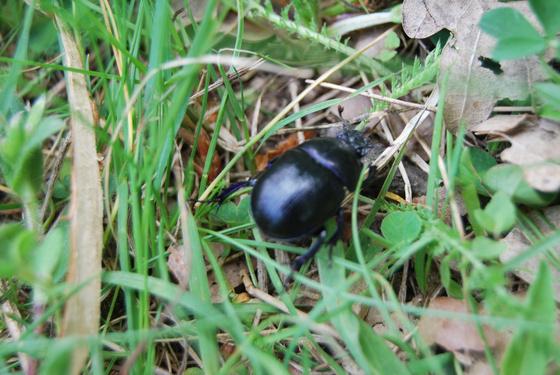Occurrence:
These beetles spread around the globe, they are extremely rich in species too, which led us to the recognition of many subfamilies. The dung beetles (Geotrupes) prefer more the moderate, while the yellow dung (Bolboceras) the hot zone residents.
Habitat:
sandy and swampy areas, fertilizers, trees and shrubs, flowers and in soil or decaying wood.
Morphology, structure:
Typically the elytrons do not completely cover their abdomen, and their tentacles can be opened-out like a diapered. The five-foot jams on the front legs (especially females) are suitable for digging. Outer edge of the front legs are disarmed with wide teeth. Their head –clypeus does not cover thir upper jaw. Their eyes are divided by the the spur of the jaw. The abdomen is formed of six rings. Clumsy, hard and strong body, which is shiny metallic steel blue or greenish.
Sexual dimorphism. Males usually have horns of various sizes on their head, while the females do not have them.
Diet:
Like most of the insects, spring beetle takes part in the disassimilation of the fallen leaves, dead animals or animal wastes and other plant metabolism.
The larvaes and adults also feed on the excrement of sheep and other wilds.
Habits:
During the day the majority of dung beetles hides or moves awkwardly and really slow on the ground while attempting a Climb-over obstacle, but it rarely succeeds. However,the spring beetlesshow up more often during the day. At dusk, especially in warm and quiet evenings they become really active, while flying with a whizzing sound, they look for an appropriate place for their nourishment and oviposition. Fresh cow manure lying on the ground, or horse manure attract them because their main diet is larger mammals’ manure. The dung beetles dug out holes and guideways in the soil, take the manure there and consume that here in safety.
Reproduction:
Males and females prepare chambers in the guideways where the females can ovulate in the manure. The male and the female encompass the manure with their front legs and they start to climb down the main guideway carrying the manure to layer them in the subchannels. The females lays one white egg. In June or July they are converted into puppets. In the first half of August, from the cocoon hatches a fresh bug, which starts maintaining its race only after hibernation.
The role on ecosystems:
Clear away the waste of the forests and meadows. They have a very important role in the circulation of the material.
The role on the soil:
With eating dung they do a useful work, not only because they clear away large amounts of material, but they also improve the soil by this.
http://mek.niif.hu/03400/03408/html/2803.html
Az állatvilág enciklopédiája A-tól Z-ig – Simon Tiller – Új Esély Kiadó Kft - Budapest, 1994
Európa vadvilága - Dönsz Judit - Graph-Art Stúdió Kft – 2000, Debrecen
Az állatvilág kalendáriuma-The Wildlife Year - 1991, London
